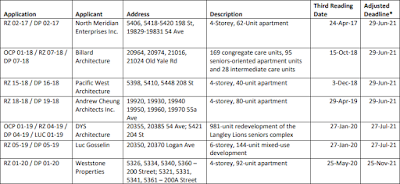Several development matters were addressed at Monday afternoon’s Langley City council meeting.
The COVID-19 pandemic has caused many economic activities to be paused or reduced; the construction industry has been impacted by the pandemic.
Rezoning bylaws require four readings (or votes in favour) by council to be adopted. Between the third reading and final reading of a rezoning bylaw, City staff work with the rezoning proponent to ensure that the proponent can follow-through on all the provisions of the rezoning bylaw. Once staff is satisfied, the final reading of a rezoning bylaw is presented to council for a vote.
Council has a policy which states that the time between third and final reading of any rezoning bylaw must not exceed a year. If a year is exceeded, a rezoning proponent needs to start at square one.
When the City issues a development permit, it is valid for a year.
Due to the COVID-19 pandemic, there are several development proposals that could reach the one-year limit. Based on a request from City staff, council approved extending the one-year limit for the following proposals:

|
| In-stream development applications adjusted time limits. Select table to enlarge. |
The City received a request from the developer of the new 69-unit apartment fronting Park Avenue and 204th Street to adjust the number of visitors parking spots from 17 to 11 to accommodate enhanced landscaping on the laneway just off 204th Street.

|
| Rendering of proposed vistors parking for Park Avenue apartment building. Select image to enlarge. |
The developer funded an independent parking study. The study's authors found that visitors parking was only half-utilized at neighbouring buildings, and noted that reducing visitors parking to 11 would meet the demand for this new building.
Council approved the reduction in visitors parking.
In November 2018, council gave third reading to a rezoning bylaw which would enable a 40-unit, four-storey apartment at 5398, 5410, 5448 208 Street (at the corner of Douglas Crescent.) Council gave final reading to this bylaw and issued a development permit yesterday. For more information about this development project, please read a previous post about it.













